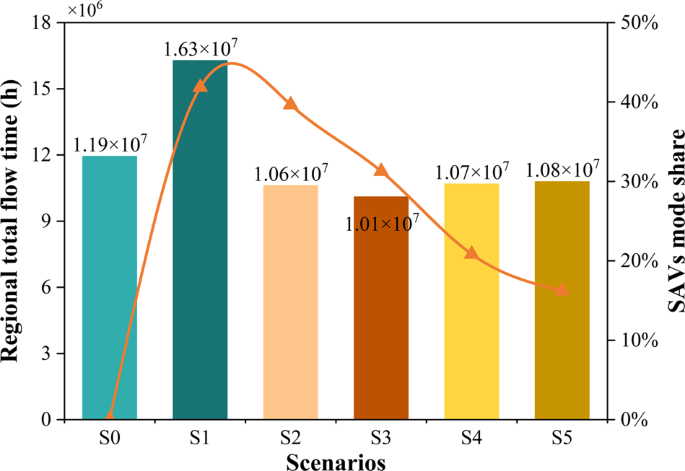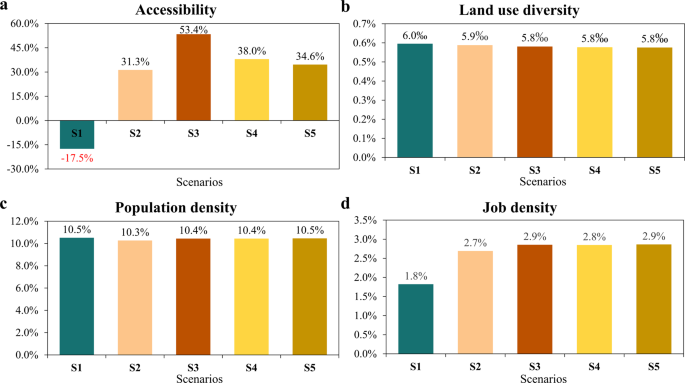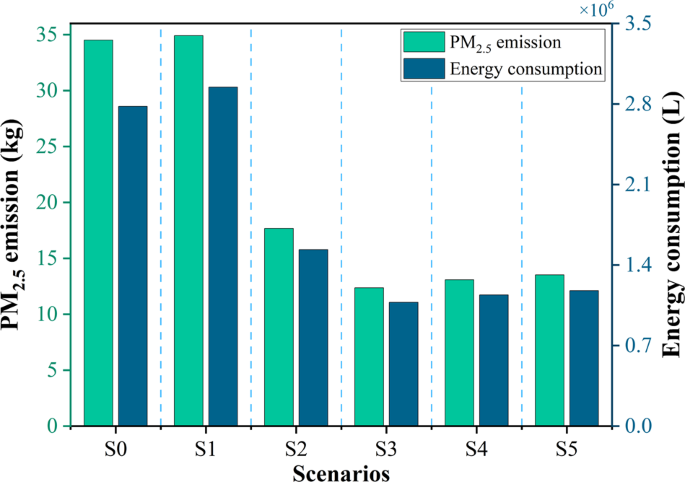Land-use and transportation effects
To better assess the effect of SAVs on urban land use, transportation, energy, and the environment, this study considered two types of regional development scenarios. The first is a business-as-usual scenario (S0), in which the city maintains the existing development mode and continues to develop6. The other is the SAV development scenario, in which SAV is introduced as an optional travel mode38. To study the effect of SAV pricing strategies on the results, five different SAV pricing scenarios were designed with reference to the market prices of similar services in the study area and related research assumptions22,25,39,40,41, namely, S1, S2, S3, S4, and S5. SAV fares increase sequentially in S1–S5. In this study, SAV fares have three parts: base fare, unit time fare, and unit distance fare, taking the US dollar as the unit. Table 1 summarizes the scenarios studied in this study. More detailed descriptions of these scenarios are provided in Supplementary Note 1.
By combining the integrated land-use and transportation model and the scenario planning method, the effects of different regional development scenarios on urban transportation and land-use systems were obtained. Figure 1 shows the changes in regional total flow time and the SAV mode share rate under different regional development scenarios. Supplementary Table 1 summarizes the transportation system performance under five SAV pricing scenarios. Figure 2 shows the different ratios for the land-use system between different SAV pricing scenarios and S0. To comprehensively reflect the effects of different regional development scenarios on the land-use system, four evaluation indicators were adopted based on 3Ds indicators for the urban built environment (i.e., density, diversity, design)42,43,44 and data availability: accessibility, land-use diversity, population density, and job density. For a detailed introduction to these indicators, please see Supplementary Note 5.
Columns represent the impact of different development scenarios on regional total flow time and different colors represent different regional development scenarios. The orange line represents SAV mode share of different development scenarios. It can be found that the low SAV pricing strategy with a higher SAV mode share is the worst scenario among all regional development scenarios in terms of regional total flow time.
SAV introduction will significantly affect the performance of the urban transportation system. First, SAVs can reduce the value of travel time (VOTT) for travelers and ease their travel burden, as passengers can work or have leisure time in vehicles. Such effects will stimulate travel demand, especially in the case of lower SAV fares, for which travelers’ VOTT is greatly reduced. In addition, SAVs may threaten the public transportation system, as public transportation typically operates on fixed routes, while SAVs are more flexible and efficient to provide door-to-door service41. Under S1, for example, the induced vehicle kilometers traveled is up 101.1%, and the share of the public transportation system is reduced to 1.7% (Supplementary Table 1). Second, SAVs can promote user travel efficiency by increasing road capacity, which is achieved by improving the utilization efficiency of road sections and intersections10,18,39. Furthermore, SAV introduction can reduce travelers’ reliance on cars and increase the share of active transportation modes, shifting the trip structure for city inhabitants toward low-carbon development17. For example, under S3, car, walking, and bicycle modes account for 10.8%, 15.0%, and 26.1%, respectively (Supplementary Table 1). Through the abovementioned effects, SAVs affect the transportation system, and those effects vary with changes in the SAV pricing strategy. Specifically, under a low SAV pricing strategy (S1), the travel time and cost savings brought by SAVs are offset by the induced travel demand, thus weakening transportation system performance and yielding a much longer total travel time than in S0—up to 36.3% (Fig. 1). In general, however, SAV introduction can significantly reduce regional total flow time and significantly improve transportation system performance (Fig. 1).
SAVs will promote the redistribution of population and jobs and affect regional accessibility. After SAV introduction, owing to changes in travel costs and convenience, users may reselect their work and residential locations, changing the population and job density of the study area and the urban land-use pattern22,27,28,29,30. Specifically, compared with S0, SAV deployment will increase job density and population density by about 2.0% and 10.0%, respectively, while having little effect on land-use diversity (about 0.6%). It is worth mentioning that the above effects do not vary significantly between different SAV pricing scenarios (S1–S5) (Fig. 2b–d). Furthermore, the redistribution of population and jobs, as well as the changes in regional total flow time, will further affect regional accessibility45,46. It is worth noting that, unlike land-use diversity and population and job density, SAV’s effect on regional accessibility shows more variation across the scenarios. More specifically, under S1, although the magnitude of SAVs’ effect on land-use diversity, job density, and population density is roughly the same as that of the other SAV pricing scenarios, the low-cost transportation system will reduce the speed, reliability, and operation efficiency of the road network (Fig. 1), reducing regional accessibility by about 17% (Fig. 2a). However, under other SAV pricing strategies, the dual improvement of transportation system performance and land-use performance will increase regional accessibility by 30%–50% (Fig. 2a).
Energy and environmental effects
Based on the above results, SAVs’ effects on energy consumption and vehicle emissions can be obtained. Energy consumption under different regional development scenarios was used to analyze the energy effect of SAVs (Fig. 4). For the environmental effect of SAVs, this study adopted two different approaches: (1) mapping the spatial distribution of vehicle emissions (including PM2.5, NOx, SO2, CO2, CO, and hydrocarbons) under different regional development scenarios to determine the overall environmental effect of SAVs (Fig. 3 and Supplementary Figs. 1–6) and (2) quantitative evaluation of the environmental implications of SAV pricing scenarios based on the spatial average of the study area (Fig. 4, and Supplementary Tables 2 and 3). For the environmental effect assessment of SAVs, this study modeled the emission of six types of vehicle emissions and exposure of five types of air pollutants (Supplementary Tables 2, 3). As six types of vehicle emissions follow the similar trends, PM2.5 is used as an example to illustrate the environmental effect of SAVs.
The spatial distribution of relative PM2.5 emission between different SAV pricing scenarios and Scenario S0 across the study area. SAV pricing scenarios incorporate Scenario S1 (a), Scenario S2 (b), Scenario S3 (c), Scenario S4 (d), and Scenario S5 (e). Orange indicates increased PM2.5 emission in SAV pricing scenarios, and green indicates reduced PM2.5 emission in SAV pricing scenarios. Supplementary Figs. 2–6 presents the impact of SAVs on the emissions of CO2 and other air pollutants. Jiangyin City, Jiangsu Province, China, is the background. This city, as a county-level city in Wuxi City, is one of six pilot smart cities under construction and was selected in this study to evaluate the impacts of SAVs.
Green columns: PM2.5 emission under different regional development scenarios across the study area. Blue columns: the impact of different development scenarios on energy consumption. It can be found that SAV fares have an important non-linear relationship with the energy and environmental impacts of SAVs.
SAV introduction can make transportation systems more environmentally friendly and energy efficient. From the quantitative results, under most SAV pricing scenarios, SAVs have a significant effect on reducing energy consumption, thus facilitating emission reduction and mitigating urban air pollution. Specifically, relative to S0, under S2, S3, S4, and S5, the environmental results of CO2 and five air pollutants are improved with SAV introduction. For example, under S3, PM2.5 emission and exposure are reduced by 64.2% and 63.5%, respectively, compared with S0 (Fig. 4, and Supplementary Tables 2, 3). Further, SAV deployment can achieve a 40%–60% reduction in energy consumption under the four SAV pricing scenarios (Fig. 4). Regarding spatial distribution, compared with S0, vehicle emissions in most parts of the study area show a descending trend under S2, S3, S4, and S5 (Fig. 3 and Supplementary Figs. 1–6). Under S0, vehicle emissions in the city center are significantly higher than in other areas owing to higher population density and more severe congestion, and most regions face great challenges in achieving green transportation (Supplementary Fig. 1). In S2, S3, S4, and S5, with SAV introduction, urban transportation performance and land-use patterns are improved, resulting in a significant reduction in six types of vehicle emissions in most areas.
When the SAV fare is low, however, SAV introduction will have a negative effect on energy consumption and the environment. Compared with S0, under S1, energy consumption and PM2.5 emission increase by 6.0% and 1.1%, respectively (Fig. 4 and Supplementary Table 2), and the other five types of vehicle emissions showed similar increases (Supplementary Tables 2, 3). It should be noted, however, that owing to changes in the spatial distribution of the population under S1, PM2.5 exposure is not higher than in S0 as expected; instead, a 5.0% reduction is achieved (Supplementary Table 3).
Optimal SAV pricing strategy
To maximize the environmental potential of SAVs, this study identified the optimal SAV pricing strategy by evaluating and comparing various regional development scenarios. The evaluation indicators were taken from the results of various models, including (1) a transportation performance indicator: regional total flow time; (2) land-use performance indicators: accessibility, land-use diversity, population density, and job density; (3) environmental performance indicators: total PM2.5 emission and average exposure; and (4) an energy performance indicator: energy consumption. Supplementary Table 4 summarizes the distance of each regional development scenario from the optimal solution and its ranking.
Comparing different SAV pricing scenarios reveals that SAV fares have a nonlinear relationship with SAVs’ effects on transportation, land use, energy use, and the environment (Figs. 1, 2a, 4). Under S1, low-cost, high-efficiency SAVs will sharply increase the time, frequency, and distance of travel and threaten the public transportation system, resulting in higher energy consumption and vehicle emissions than other development scenarios (Fig. 4). By increasing the SAV price, excessive travel demand will be curbed, thus reducing energy consumption and emissions. Moreover, this improvement effect is maximized in S3 (Fig. 4 and Supplementary Tables 2 and 3). However, a further increase in SAV fares will lead to a decrease in SAV mode share. This will decrease SAVs’ effectiveness in promoting transportation efficiency and accessibility (Figs. 1 and 2a) and gradually increase energy consumption and vehicle emissions (Fig. 4), thus weakening their energy-saving and environmental improvement effects.
In summary, S3, as the optimal SAV pricing scenario for Jiangyin City, will not only maximize the benefits of SAVs but also reduce their potential adverse effects on energy and the environment. Consequently, an appropriate SAV pricing strategy is essential for fully exploiting the potential of SAVs in promoting sustainable development8.
Furthermore, this study tested the impact of vehicle occupancy on the optimal SAV pricing scenario (S3), shown in Supplementary Table 5. The SAV vehicle occupancy adopted in this study is 3.0, which is applicable for S1-S5. When the SAV vehicle occupancy of S3 is adjusted to the current China average level (namely 1.3) and moderate SAV vehicle occupancy (namely 2.0), the effects of SAVs in improving the total flow time and regional accessibility will be impaired, the environmental benefits of S3 are weakened, and the improvement ratio of PM2.5 emission is reduced to 56.0% and 61.1%, respectively (Supplementary Table 5).
Environmental benefit for fleet electrification
To further assess the effect of vehicle electrification on vehicle emissions and energy consumption, four shared autonomous electric vehicle (SAEV) development scenarios were designed based on the optimal SAV pricing scenario (S3), namely, E1, E2, E3, and E4. These scenarios look at (1) the rate of vehicle electrification (both SAVs and non-automated vehicles), (2) EV energy efficiency (kWh km−1), and (3) emission levels from electricity generation (g kWh−1)6. Specifically, the EV energy efficiency and emission level from electricity generation under E1 maintain the current level while E2 and E3 consider a cleaner generation mix in the electric power structure and advances in EV energy efficiency, respectively. E4 considers developments in both generation mix and energy efficiency. More detailed descriptions of vehicle electrification scenarios are provided in Supplementary Note 7 and Supplementary Table 17.
The electrification of the SAV fleet can further enhance environmental and energy benefits. Relative to S3, PM2.5, CO2, and NOx emissions under E1 are reduced by 13.8%, 16.5%, and 6.9%, respectively (Fig. 5). Furthermore, comparing the spatial distribution of six types of vehicle emissions under the two scenarios reveals that vehicle electrification plays a significant role in further mitigating vehicle emission problems (Supplementary Figs. 7–12). Under E2 and E3, the effects of SAEVs in terms of environmental improvement are more significant since decarbonization of the electric power sector and EV energy efficiency improvement are considered. Specifically, under E2 and E3, PM2.5 emissions are reduced by 33.2% and 22.2%, respectively (Fig. 5). In addition, comparing E2 and E3, vehicle emissions are more sensitive to emission levels from electricity generation than to EV energy efficiency. That is, lowering the emission level from electricity generation is more effective for reducing CO2 and air pollutants emissions than advancements in EV energy efficiency (Supplementary Tables 6–8). If technical innovations in vehicle electrification, electric power structure, and vehicle energy consumption are considered simultaneously, then the six types of vehicle emissions will be further reduced, in which the emission reductions of PM2.5, CO2, and NOx emissions will reach 34.0%, 30.3%, and 29.7%, respectively, under E4 (Fig. 5). In addition, compared with S0, PM2.5 emission and energy consumption under E4 decrease substantially, up to 76.4% and 74.2%, respectively (Supplementary Tables 6–8).
Scenario E1 further considers vehicle electrification based on Scenario S3, and EV energy efficiency and emission levels from electricity generation are both at the current level. Scenarios E2 and E3 build on Scenario E1 by considering a cleaner generation mix in the electric power structure and advances in EV energy efficiency, respectively. Scenario E4 takes into account three technical innovations: vehicle electrification, EV energy consumption, and electric power structure. Grey icons represent current levels, and green icons represent future levels.














